ICMS MKT300: Woolworths Strategic Marketing Planning Workbook
VerifiedAdded on 2023/06/10
|15
|3744
|190
Report
AI Summary
This report presents a strategic marketing plan for Woolworths, a major Australian retailer, employing various analytical tools to assess its market position and competitive landscape. The report begins with an introduction to strategic management and its importance in achieving organizational goals, followed by a company background of Woolworths, highlighting its history and current operations. A PESTLE analysis examines the political, economic, social, technological, environmental, and legal factors influencing Woolworths' business. Porter's Five Forces analysis evaluates the bargaining power of suppliers and buyers, the threat of new entrants and substitutes, and the intensity of competitive rivalry. The report also includes a competitor analysis, identifying key competitors such as Coles and ALDI, and a SWOT analysis, outlining Woolworths' strengths, weaknesses, opportunities, and threats. The analysis provides a comprehensive overview of the factors impacting Woolworths' strategic decision-making and offers recommendations for future growth and sustainability.
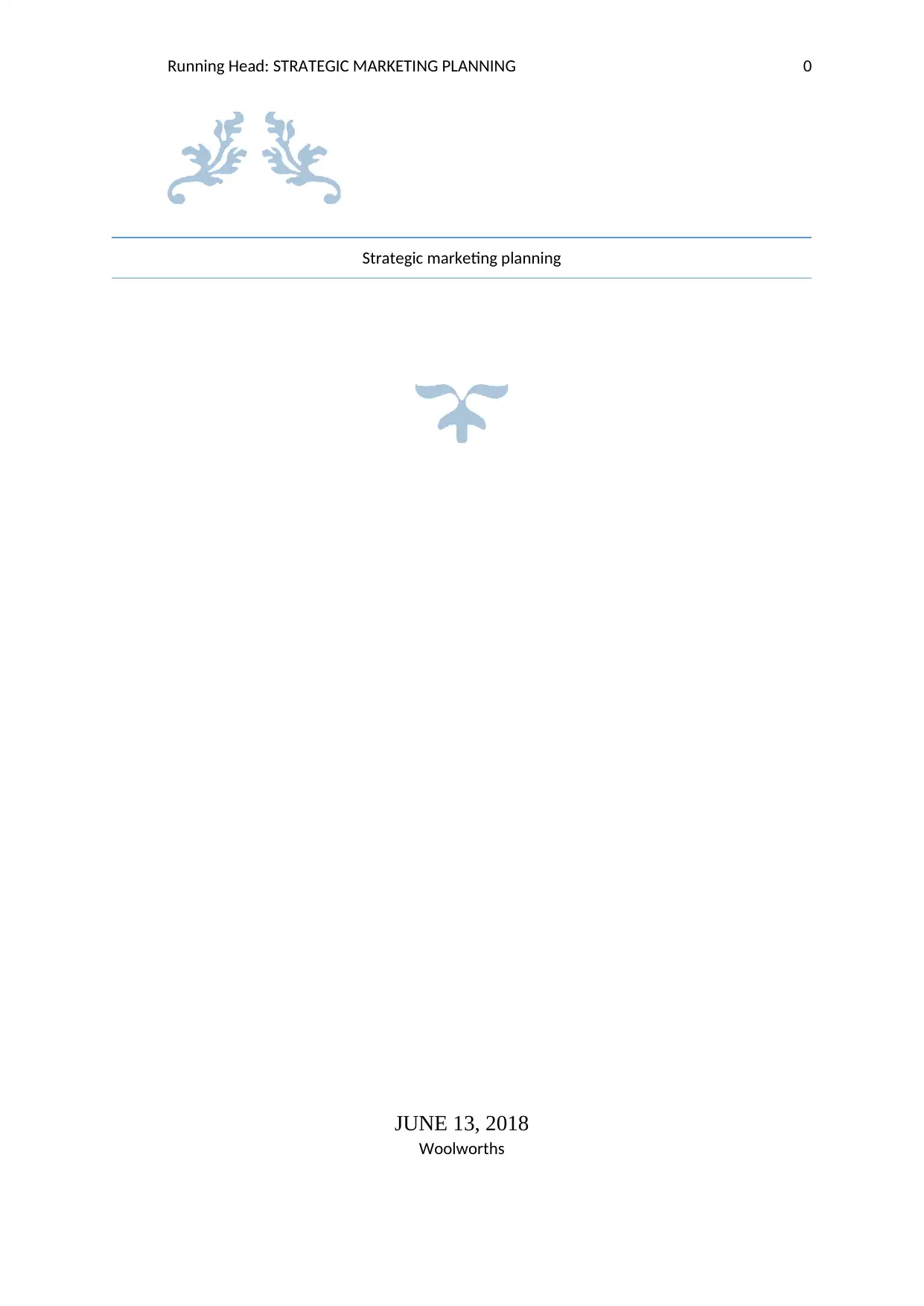
Running Head: STRATEGIC MARKETING PLANNING 0
Strategic marketing planning
JUNE 13, 2018
Woolworths
Strategic marketing planning
JUNE 13, 2018
Woolworths
Paraphrase This Document
Need a fresh take? Get an instant paraphrase of this document with our AI Paraphraser
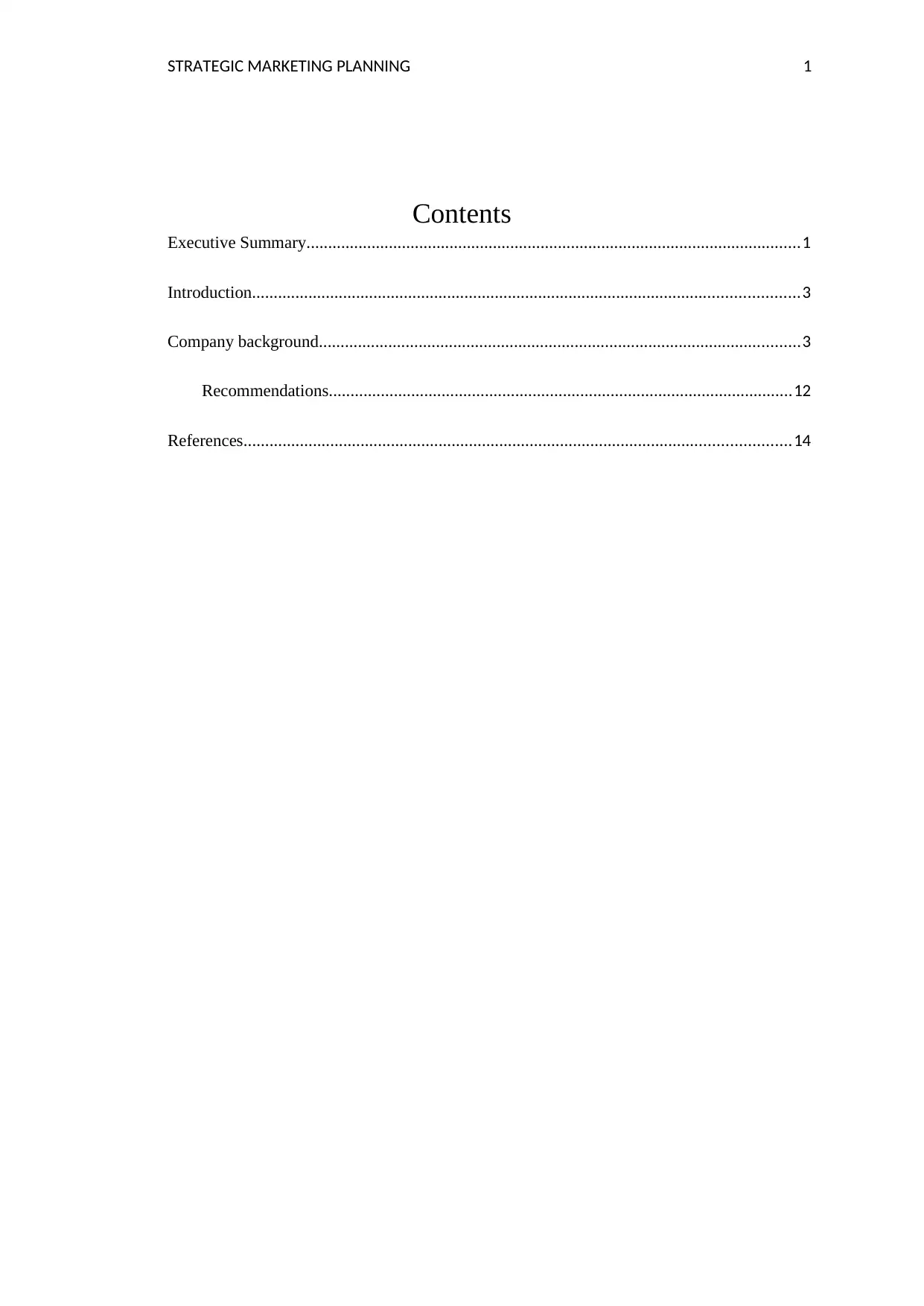
STRATEGIC MARKETING PLANNING 1
Contents
Executive Summary..................................................................................................................1
Introduction..............................................................................................................................3
Company background...............................................................................................................3
Recommendations...........................................................................................................12
References..............................................................................................................................14
Contents
Executive Summary..................................................................................................................1
Introduction..............................................................................................................................3
Company background...............................................................................................................3
Recommendations...........................................................................................................12
References..............................................................................................................................14

STRATEGIC MARKETING PLANNING 2
Executive Summary
The diversified nature of business operations in today’s era has led to globalization,
which stresses the implementations of essential strategies. Strategic management in every
organization plays a major role in accomplishing the goals and objectives. It describes the
planning for the long-term as well as goals. For, the execution of set plans and strategies it
requires a proper and smooth functioning of any organization. With respect to the
environment in which a business organization operates, they are subject to various external
influences. These influences may be in the form of factors such as political, legal, social,
environmental, and technological. The report further demonstrates these factors in the context
of an Australian second largest retailer Woolworths, which is a well-known supermarket after
Coles. In addition, the analysis of the company has done using certain parameters such as
SWOT analysis, PESTEL analysis, and Porter’s five forces. This analysis has been done
while identifying the competitors in the market. Woolworths has been growing at a faster
pace in terms of the market segmentation strategy that also led to the market attractiveness.
Thus, Woolworths has been consistent in conducting operations worldwide.
Executive Summary
The diversified nature of business operations in today’s era has led to globalization,
which stresses the implementations of essential strategies. Strategic management in every
organization plays a major role in accomplishing the goals and objectives. It describes the
planning for the long-term as well as goals. For, the execution of set plans and strategies it
requires a proper and smooth functioning of any organization. With respect to the
environment in which a business organization operates, they are subject to various external
influences. These influences may be in the form of factors such as political, legal, social,
environmental, and technological. The report further demonstrates these factors in the context
of an Australian second largest retailer Woolworths, which is a well-known supermarket after
Coles. In addition, the analysis of the company has done using certain parameters such as
SWOT analysis, PESTEL analysis, and Porter’s five forces. This analysis has been done
while identifying the competitors in the market. Woolworths has been growing at a faster
pace in terms of the market segmentation strategy that also led to the market attractiveness.
Thus, Woolworths has been consistent in conducting operations worldwide.
⊘ This is a preview!⊘
Do you want full access?
Subscribe today to unlock all pages.

Trusted by 1+ million students worldwide
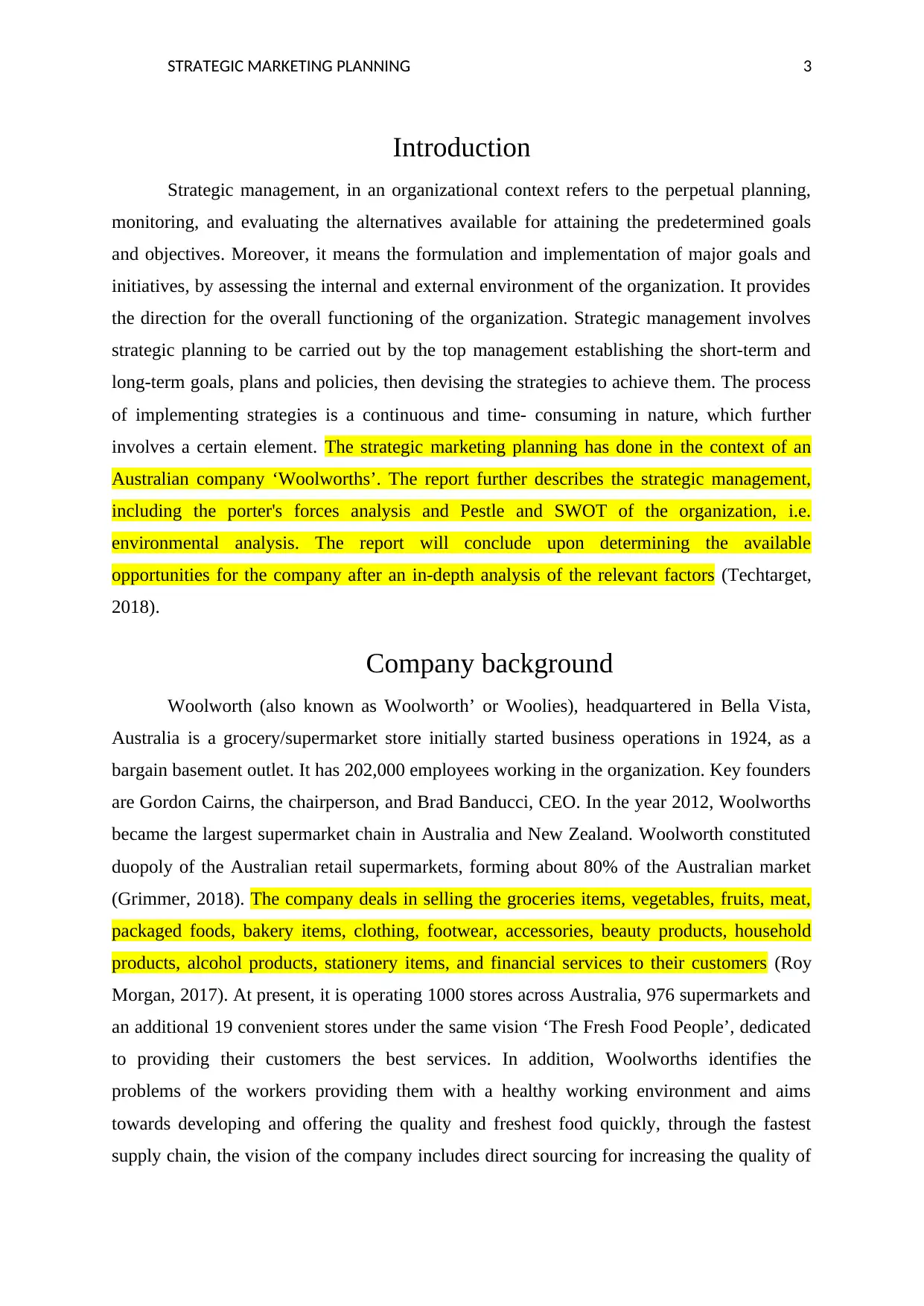
STRATEGIC MARKETING PLANNING 3
Introduction
Strategic management, in an organizational context refers to the perpetual planning,
monitoring, and evaluating the alternatives available for attaining the predetermined goals
and objectives. Moreover, it means the formulation and implementation of major goals and
initiatives, by assessing the internal and external environment of the organization. It provides
the direction for the overall functioning of the organization. Strategic management involves
strategic planning to be carried out by the top management establishing the short-term and
long-term goals, plans and policies, then devising the strategies to achieve them. The process
of implementing strategies is a continuous and time- consuming in nature, which further
involves a certain element. The strategic marketing planning has done in the context of an
Australian company ‘Woolworths’. The report further describes the strategic management,
including the porter's forces analysis and Pestle and SWOT of the organization, i.e.
environmental analysis. The report will conclude upon determining the available
opportunities for the company after an in-depth analysis of the relevant factors (Techtarget,
2018).
Company background
Woolworth (also known as Woolworth’ or Woolies), headquartered in Bella Vista,
Australia is a grocery/supermarket store initially started business operations in 1924, as a
bargain basement outlet. It has 202,000 employees working in the organization. Key founders
are Gordon Cairns, the chairperson, and Brad Banducci, CEO. In the year 2012, Woolworths
became the largest supermarket chain in Australia and New Zealand. Woolworth constituted
duopoly of the Australian retail supermarkets, forming about 80% of the Australian market
(Grimmer, 2018). The company deals in selling the groceries items, vegetables, fruits, meat,
packaged foods, bakery items, clothing, footwear, accessories, beauty products, household
products, alcohol products, stationery items, and financial services to their customers (Roy
Morgan, 2017). At present, it is operating 1000 stores across Australia, 976 supermarkets and
an additional 19 convenient stores under the same vision ‘The Fresh Food People’, dedicated
to providing their customers the best services. In addition, Woolworths identifies the
problems of the workers providing them with a healthy working environment and aims
towards developing and offering the quality and freshest food quickly, through the fastest
supply chain, the vision of the company includes direct sourcing for increasing the quality of
Introduction
Strategic management, in an organizational context refers to the perpetual planning,
monitoring, and evaluating the alternatives available for attaining the predetermined goals
and objectives. Moreover, it means the formulation and implementation of major goals and
initiatives, by assessing the internal and external environment of the organization. It provides
the direction for the overall functioning of the organization. Strategic management involves
strategic planning to be carried out by the top management establishing the short-term and
long-term goals, plans and policies, then devising the strategies to achieve them. The process
of implementing strategies is a continuous and time- consuming in nature, which further
involves a certain element. The strategic marketing planning has done in the context of an
Australian company ‘Woolworths’. The report further describes the strategic management,
including the porter's forces analysis and Pestle and SWOT of the organization, i.e.
environmental analysis. The report will conclude upon determining the available
opportunities for the company after an in-depth analysis of the relevant factors (Techtarget,
2018).
Company background
Woolworth (also known as Woolworth’ or Woolies), headquartered in Bella Vista,
Australia is a grocery/supermarket store initially started business operations in 1924, as a
bargain basement outlet. It has 202,000 employees working in the organization. Key founders
are Gordon Cairns, the chairperson, and Brad Banducci, CEO. In the year 2012, Woolworths
became the largest supermarket chain in Australia and New Zealand. Woolworth constituted
duopoly of the Australian retail supermarkets, forming about 80% of the Australian market
(Grimmer, 2018). The company deals in selling the groceries items, vegetables, fruits, meat,
packaged foods, bakery items, clothing, footwear, accessories, beauty products, household
products, alcohol products, stationery items, and financial services to their customers (Roy
Morgan, 2017). At present, it is operating 1000 stores across Australia, 976 supermarkets and
an additional 19 convenient stores under the same vision ‘The Fresh Food People’, dedicated
to providing their customers the best services. In addition, Woolworths identifies the
problems of the workers providing them with a healthy working environment and aims
towards developing and offering the quality and freshest food quickly, through the fastest
supply chain, the vision of the company includes direct sourcing for increasing the quality of
Paraphrase This Document
Need a fresh take? Get an instant paraphrase of this document with our AI Paraphraser

STRATEGIC MARKETING PLANNING 4
their produce. Woolworth's environmental analysis has been done, with their Pestle and Swot
analysis which describes the strengths and opportunities of the company used to gain the
competitive edge in the industry (WHL, 2018).
PESTLE Analysis
Pestle Analysis refers to the framework or tool used by the marketers or management
of the organization to analyze and assess the impact of external influences on the businesses
and their working. By understanding and evaluating the external environment, an
organization can strengthen the opportunities and reduce risks to attain positive outcomes and
increased profits (Process policy, 2018). This tool is used for the strategic planning of the
business, which includes many macro-environment factors such as new laws, tax charges,
interest rates, economic growth, per capita income, trade barriers, population growth, health
consciousness, and technological changes, affecting the performance, and working of the
organization. Therefore, PESTEL stands for Political, Economic, Social, Technological,
Economic, and Legal factors. PESTEL analysis in the context of the company
‘WOOLWORTHS’ is explained as below in the form of a table (S&P, 2017).
POLITICAL ECONOMICAL
There are political pressures for the
duopolistic nature of the organization,
dealing in retail business.
Although Australia is economically and
politically stable, therefore, Woolworths
gets in advantageous position in the
retail sector.
Unaware customers, who lack
knowledge, affect the retailers in
Australia.
Woolworths operates at both the places,
Australia, and New Zealand, which are
economically sound countries.
Therefore, business operations carried
out at Woolworths gain economic
advantages.
SOCIAL TECHNOLOGICAL
Woolworths has a poor relationship with
the suppliers that create disputes in the
The technological factors in PESTLE
analysis are the implementation of the
their produce. Woolworth's environmental analysis has been done, with their Pestle and Swot
analysis which describes the strengths and opportunities of the company used to gain the
competitive edge in the industry (WHL, 2018).
PESTLE Analysis
Pestle Analysis refers to the framework or tool used by the marketers or management
of the organization to analyze and assess the impact of external influences on the businesses
and their working. By understanding and evaluating the external environment, an
organization can strengthen the opportunities and reduce risks to attain positive outcomes and
increased profits (Process policy, 2018). This tool is used for the strategic planning of the
business, which includes many macro-environment factors such as new laws, tax charges,
interest rates, economic growth, per capita income, trade barriers, population growth, health
consciousness, and technological changes, affecting the performance, and working of the
organization. Therefore, PESTEL stands for Political, Economic, Social, Technological,
Economic, and Legal factors. PESTEL analysis in the context of the company
‘WOOLWORTHS’ is explained as below in the form of a table (S&P, 2017).
POLITICAL ECONOMICAL
There are political pressures for the
duopolistic nature of the organization,
dealing in retail business.
Although Australia is economically and
politically stable, therefore, Woolworths
gets in advantageous position in the
retail sector.
Unaware customers, who lack
knowledge, affect the retailers in
Australia.
Woolworths operates at both the places,
Australia, and New Zealand, which are
economically sound countries.
Therefore, business operations carried
out at Woolworths gain economic
advantages.
SOCIAL TECHNOLOGICAL
Woolworths has a poor relationship with
the suppliers that create disputes in the
The technological factors in PESTLE
analysis are the implementation of the
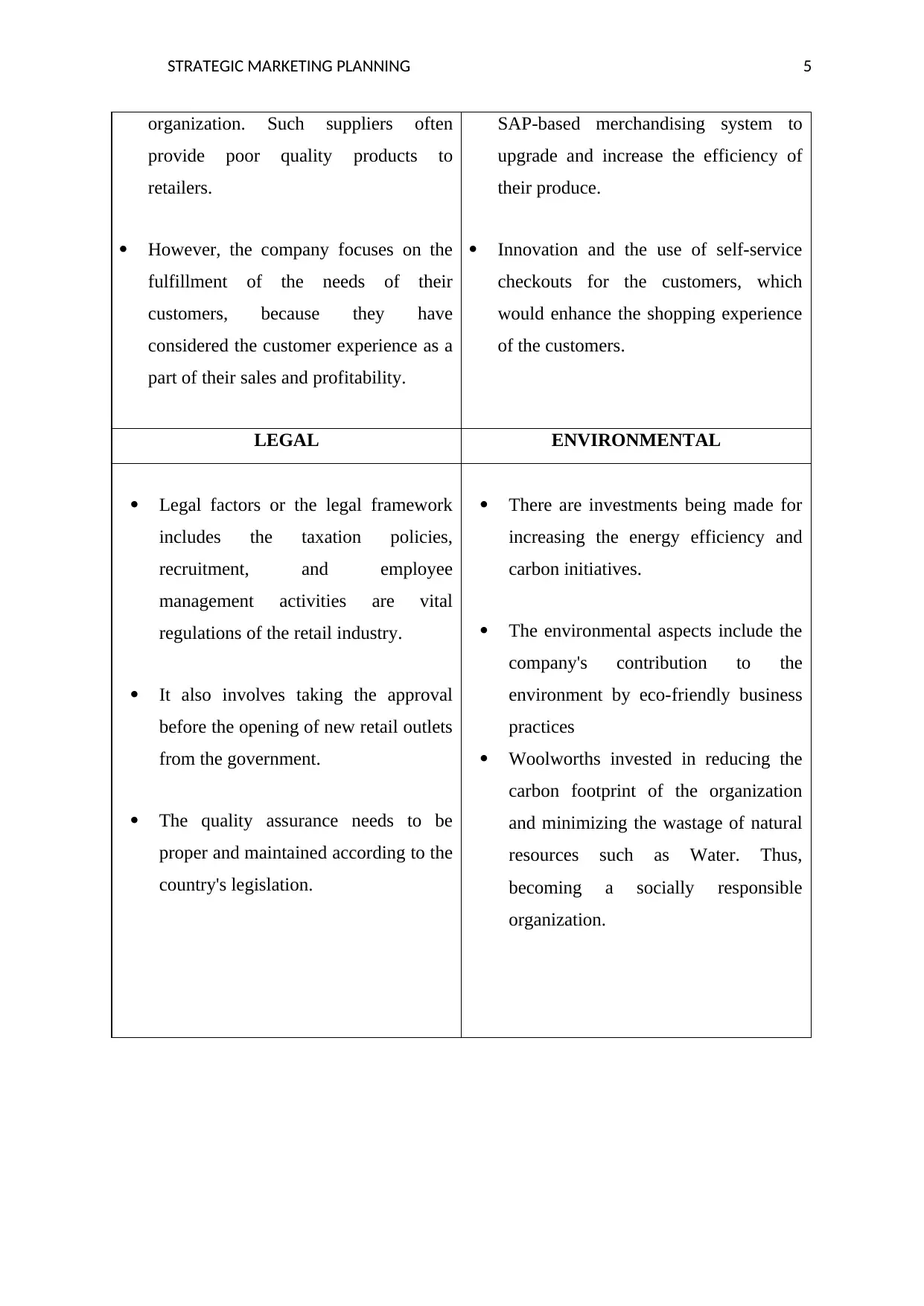
STRATEGIC MARKETING PLANNING 5
organization. Such suppliers often
provide poor quality products to
retailers.
However, the company focuses on the
fulfillment of the needs of their
customers, because they have
considered the customer experience as a
part of their sales and profitability.
SAP-based merchandising system to
upgrade and increase the efficiency of
their produce.
Innovation and the use of self-service
checkouts for the customers, which
would enhance the shopping experience
of the customers.
LEGAL ENVIRONMENTAL
Legal factors or the legal framework
includes the taxation policies,
recruitment, and employee
management activities are vital
regulations of the retail industry.
It also involves taking the approval
before the opening of new retail outlets
from the government.
The quality assurance needs to be
proper and maintained according to the
country's legislation.
There are investments being made for
increasing the energy efficiency and
carbon initiatives.
The environmental aspects include the
company's contribution to the
environment by eco-friendly business
practices
Woolworths invested in reducing the
carbon footprint of the organization
and minimizing the wastage of natural
resources such as Water. Thus,
becoming a socially responsible
organization.
organization. Such suppliers often
provide poor quality products to
retailers.
However, the company focuses on the
fulfillment of the needs of their
customers, because they have
considered the customer experience as a
part of their sales and profitability.
SAP-based merchandising system to
upgrade and increase the efficiency of
their produce.
Innovation and the use of self-service
checkouts for the customers, which
would enhance the shopping experience
of the customers.
LEGAL ENVIRONMENTAL
Legal factors or the legal framework
includes the taxation policies,
recruitment, and employee
management activities are vital
regulations of the retail industry.
It also involves taking the approval
before the opening of new retail outlets
from the government.
The quality assurance needs to be
proper and maintained according to the
country's legislation.
There are investments being made for
increasing the energy efficiency and
carbon initiatives.
The environmental aspects include the
company's contribution to the
environment by eco-friendly business
practices
Woolworths invested in reducing the
carbon footprint of the organization
and minimizing the wastage of natural
resources such as Water. Thus,
becoming a socially responsible
organization.
⊘ This is a preview!⊘
Do you want full access?
Subscribe today to unlock all pages.

Trusted by 1+ million students worldwide
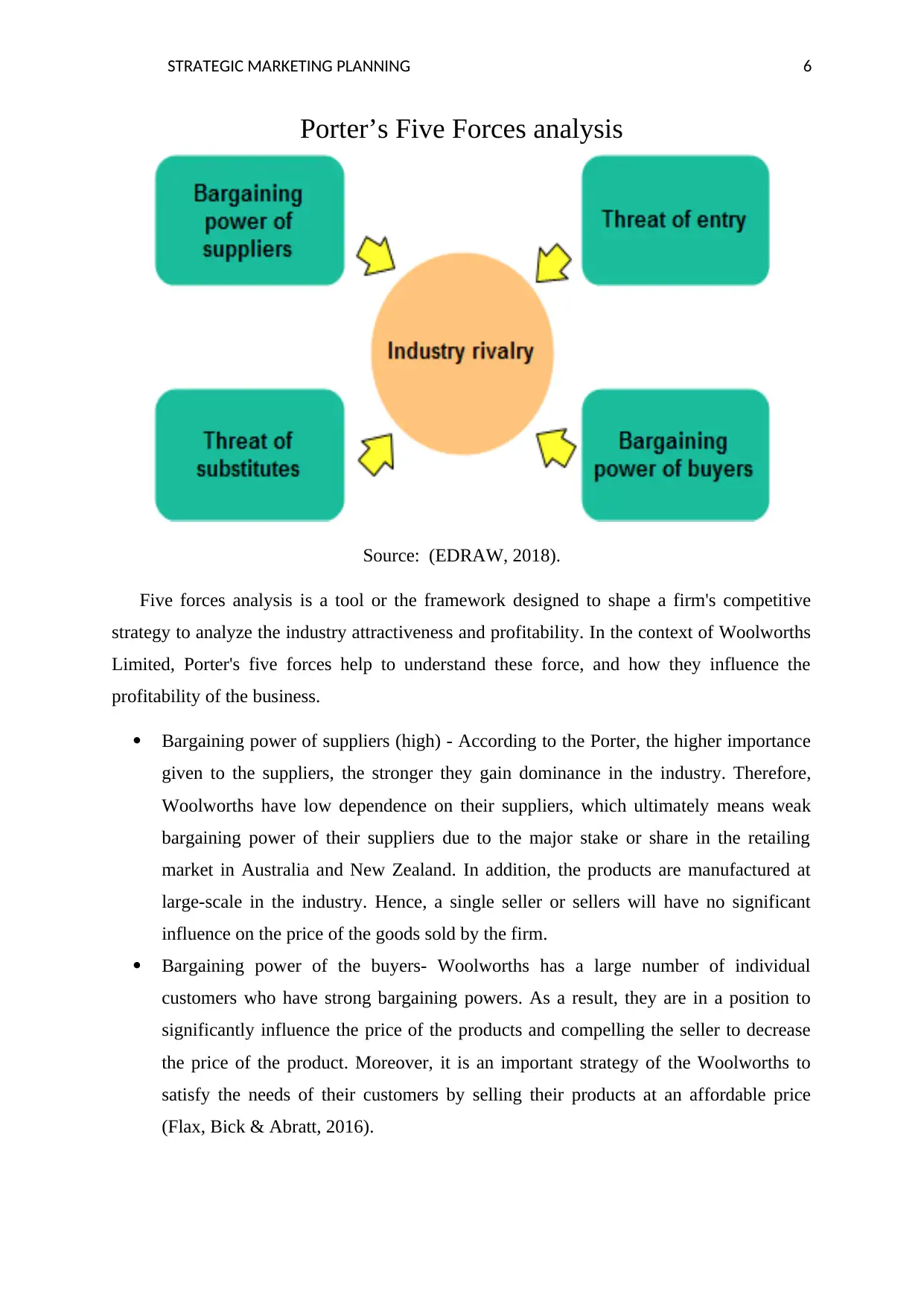
STRATEGIC MARKETING PLANNING 6
Porter’s Five Forces analysis
Source: (EDRAW, 2018).
Five forces analysis is a tool or the framework designed to shape a firm's competitive
strategy to analyze the industry attractiveness and profitability. In the context of Woolworths
Limited, Porter's five forces help to understand these force, and how they influence the
profitability of the business.
Bargaining power of suppliers (high) - According to the Porter, the higher importance
given to the suppliers, the stronger they gain dominance in the industry. Therefore,
Woolworths have low dependence on their suppliers, which ultimately means weak
bargaining power of their suppliers due to the major stake or share in the retailing
market in Australia and New Zealand. In addition, the products are manufactured at
large-scale in the industry. Hence, a single seller or sellers will have no significant
influence on the price of the goods sold by the firm.
Bargaining power of the buyers- Woolworths has a large number of individual
customers who have strong bargaining powers. As a result, they are in a position to
significantly influence the price of the products and compelling the seller to decrease
the price of the product. Moreover, it is an important strategy of the Woolworths to
satisfy the needs of their customers by selling their products at an affordable price
(Flax, Bick & Abratt, 2016).
Porter’s Five Forces analysis
Source: (EDRAW, 2018).
Five forces analysis is a tool or the framework designed to shape a firm's competitive
strategy to analyze the industry attractiveness and profitability. In the context of Woolworths
Limited, Porter's five forces help to understand these force, and how they influence the
profitability of the business.
Bargaining power of suppliers (high) - According to the Porter, the higher importance
given to the suppliers, the stronger they gain dominance in the industry. Therefore,
Woolworths have low dependence on their suppliers, which ultimately means weak
bargaining power of their suppliers due to the major stake or share in the retailing
market in Australia and New Zealand. In addition, the products are manufactured at
large-scale in the industry. Hence, a single seller or sellers will have no significant
influence on the price of the goods sold by the firm.
Bargaining power of the buyers- Woolworths has a large number of individual
customers who have strong bargaining powers. As a result, they are in a position to
significantly influence the price of the products and compelling the seller to decrease
the price of the product. Moreover, it is an important strategy of the Woolworths to
satisfy the needs of their customers by selling their products at an affordable price
(Flax, Bick & Abratt, 2016).
Paraphrase This Document
Need a fresh take? Get an instant paraphrase of this document with our AI Paraphraser
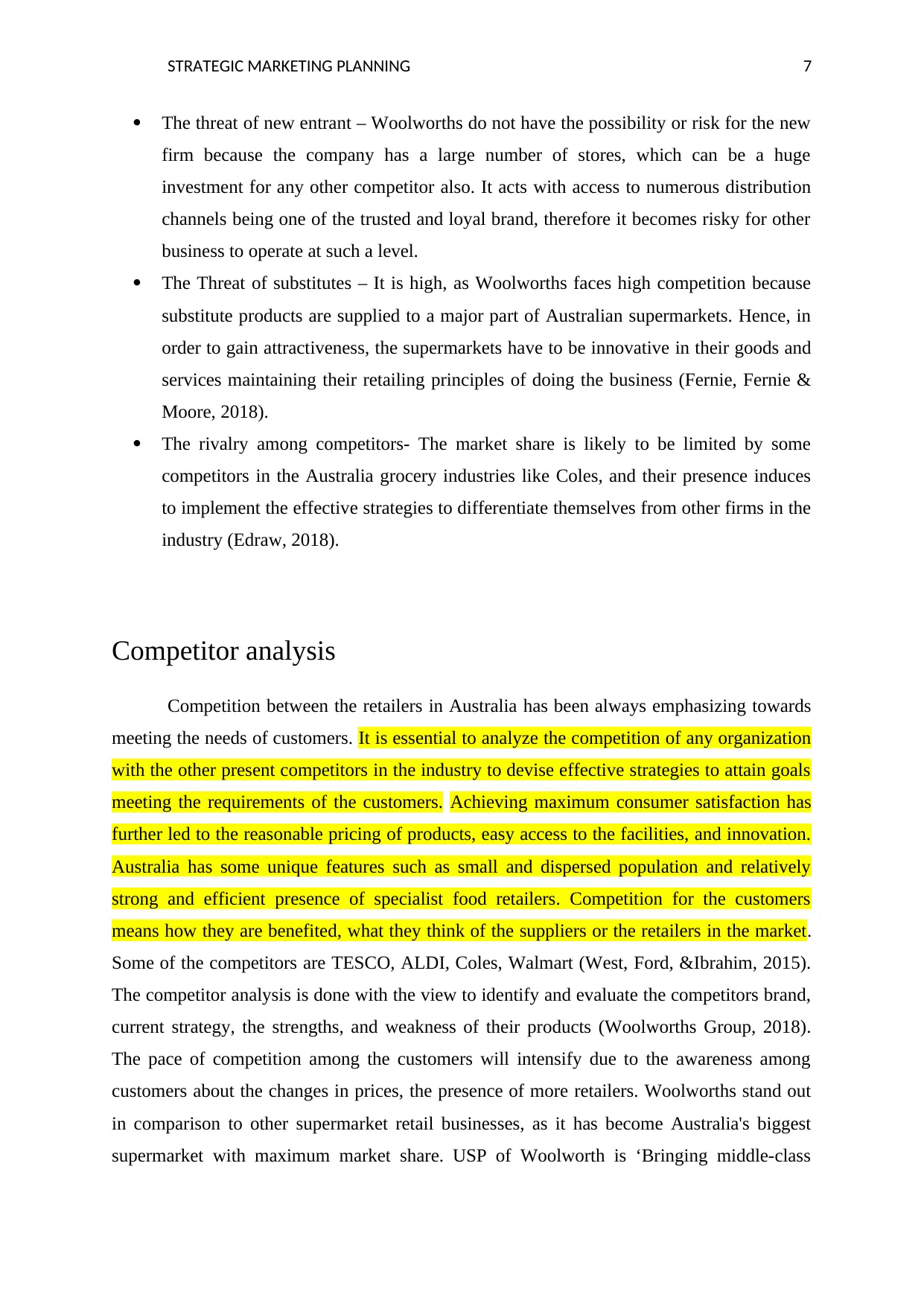
STRATEGIC MARKETING PLANNING 7
The threat of new entrant – Woolworths do not have the possibility or risk for the new
firm because the company has a large number of stores, which can be a huge
investment for any other competitor also. It acts with access to numerous distribution
channels being one of the trusted and loyal brand, therefore it becomes risky for other
business to operate at such a level.
The Threat of substitutes – It is high, as Woolworths faces high competition because
substitute products are supplied to a major part of Australian supermarkets. Hence, in
order to gain attractiveness, the supermarkets have to be innovative in their goods and
services maintaining their retailing principles of doing the business (Fernie, Fernie &
Moore, 2018).
The rivalry among competitors- The market share is likely to be limited by some
competitors in the Australia grocery industries like Coles, and their presence induces
to implement the effective strategies to differentiate themselves from other firms in the
industry (Edraw, 2018).
Competitor analysis
Competition between the retailers in Australia has been always emphasizing towards
meeting the needs of customers. It is essential to analyze the competition of any organization
with the other present competitors in the industry to devise effective strategies to attain goals
meeting the requirements of the customers. Achieving maximum consumer satisfaction has
further led to the reasonable pricing of products, easy access to the facilities, and innovation.
Australia has some unique features such as small and dispersed population and relatively
strong and efficient presence of specialist food retailers. Competition for the customers
means how they are benefited, what they think of the suppliers or the retailers in the market.
Some of the competitors are TESCO, ALDI, Coles, Walmart (West, Ford, &Ibrahim, 2015).
The competitor analysis is done with the view to identify and evaluate the competitors brand,
current strategy, the strengths, and weakness of their products (Woolworths Group, 2018).
The pace of competition among the customers will intensify due to the awareness among
customers about the changes in prices, the presence of more retailers. Woolworths stand out
in comparison to other supermarket retail businesses, as it has become Australia's biggest
supermarket with maximum market share. USP of Woolworth is ‘Bringing middle-class
The threat of new entrant – Woolworths do not have the possibility or risk for the new
firm because the company has a large number of stores, which can be a huge
investment for any other competitor also. It acts with access to numerous distribution
channels being one of the trusted and loyal brand, therefore it becomes risky for other
business to operate at such a level.
The Threat of substitutes – It is high, as Woolworths faces high competition because
substitute products are supplied to a major part of Australian supermarkets. Hence, in
order to gain attractiveness, the supermarkets have to be innovative in their goods and
services maintaining their retailing principles of doing the business (Fernie, Fernie &
Moore, 2018).
The rivalry among competitors- The market share is likely to be limited by some
competitors in the Australia grocery industries like Coles, and their presence induces
to implement the effective strategies to differentiate themselves from other firms in the
industry (Edraw, 2018).
Competitor analysis
Competition between the retailers in Australia has been always emphasizing towards
meeting the needs of customers. It is essential to analyze the competition of any organization
with the other present competitors in the industry to devise effective strategies to attain goals
meeting the requirements of the customers. Achieving maximum consumer satisfaction has
further led to the reasonable pricing of products, easy access to the facilities, and innovation.
Australia has some unique features such as small and dispersed population and relatively
strong and efficient presence of specialist food retailers. Competition for the customers
means how they are benefited, what they think of the suppliers or the retailers in the market.
Some of the competitors are TESCO, ALDI, Coles, Walmart (West, Ford, &Ibrahim, 2015).
The competitor analysis is done with the view to identify and evaluate the competitors brand,
current strategy, the strengths, and weakness of their products (Woolworths Group, 2018).
The pace of competition among the customers will intensify due to the awareness among
customers about the changes in prices, the presence of more retailers. Woolworths stand out
in comparison to other supermarket retail businesses, as it has become Australia's biggest
supermarket with maximum market share. USP of Woolworth is ‘Bringing middle-class

STRATEGIC MARKETING PLANNING 8
products into working-class homes' targets upper class and working for population whereas
competitors such as Coles targeting middle class and premium households (Australian Food
News, 2017).
SWOT Analysis –
The analysis of the Woolworths can be described in the form of a table below-
STRENGTHS WEAKNESSES
Woolworths has been the oldest and
well-known retail brands in the
Australian market.
It employees a large number of people in
the company around 2, 20,000.
Diversified products and services to the
Customers.
Effectively implements CSR strategies
and other policies.
Strongly committed towards the
environment and sustainability.
Presence of a large number of
supermarkets.
Enhancement of the leadership position
of the company is facilitated because of
the strong and effective human resource,
advanced technologies.
Woolworths has a low international
presence for carrying the business
operations.
It accounted as a latecomer or ‘Late
entry’ in the retail industry.
The company lost the competitive
advantage to the competitors or other
retailers in the market.
One of the weaknesses of the
organization has been the growth
strategy that is mainly the impact of
the conditions of the external
environment of Woolworths restricting
in dominating the Australian market.
Moreover, the Australian government
restricts the company to keep higher
prices for its product that also acts as a
factor indicating weakness.
OPPORTUNITIES THREATS
products into working-class homes' targets upper class and working for population whereas
competitors such as Coles targeting middle class and premium households (Australian Food
News, 2017).
SWOT Analysis –
The analysis of the Woolworths can be described in the form of a table below-
STRENGTHS WEAKNESSES
Woolworths has been the oldest and
well-known retail brands in the
Australian market.
It employees a large number of people in
the company around 2, 20,000.
Diversified products and services to the
Customers.
Effectively implements CSR strategies
and other policies.
Strongly committed towards the
environment and sustainability.
Presence of a large number of
supermarkets.
Enhancement of the leadership position
of the company is facilitated because of
the strong and effective human resource,
advanced technologies.
Woolworths has a low international
presence for carrying the business
operations.
It accounted as a latecomer or ‘Late
entry’ in the retail industry.
The company lost the competitive
advantage to the competitors or other
retailers in the market.
One of the weaknesses of the
organization has been the growth
strategy that is mainly the impact of
the conditions of the external
environment of Woolworths restricting
in dominating the Australian market.
Moreover, the Australian government
restricts the company to keep higher
prices for its product that also acts as a
factor indicating weakness.
OPPORTUNITIES THREATS
⊘ This is a preview!⊘
Do you want full access?
Subscribe today to unlock all pages.

Trusted by 1+ million students worldwide
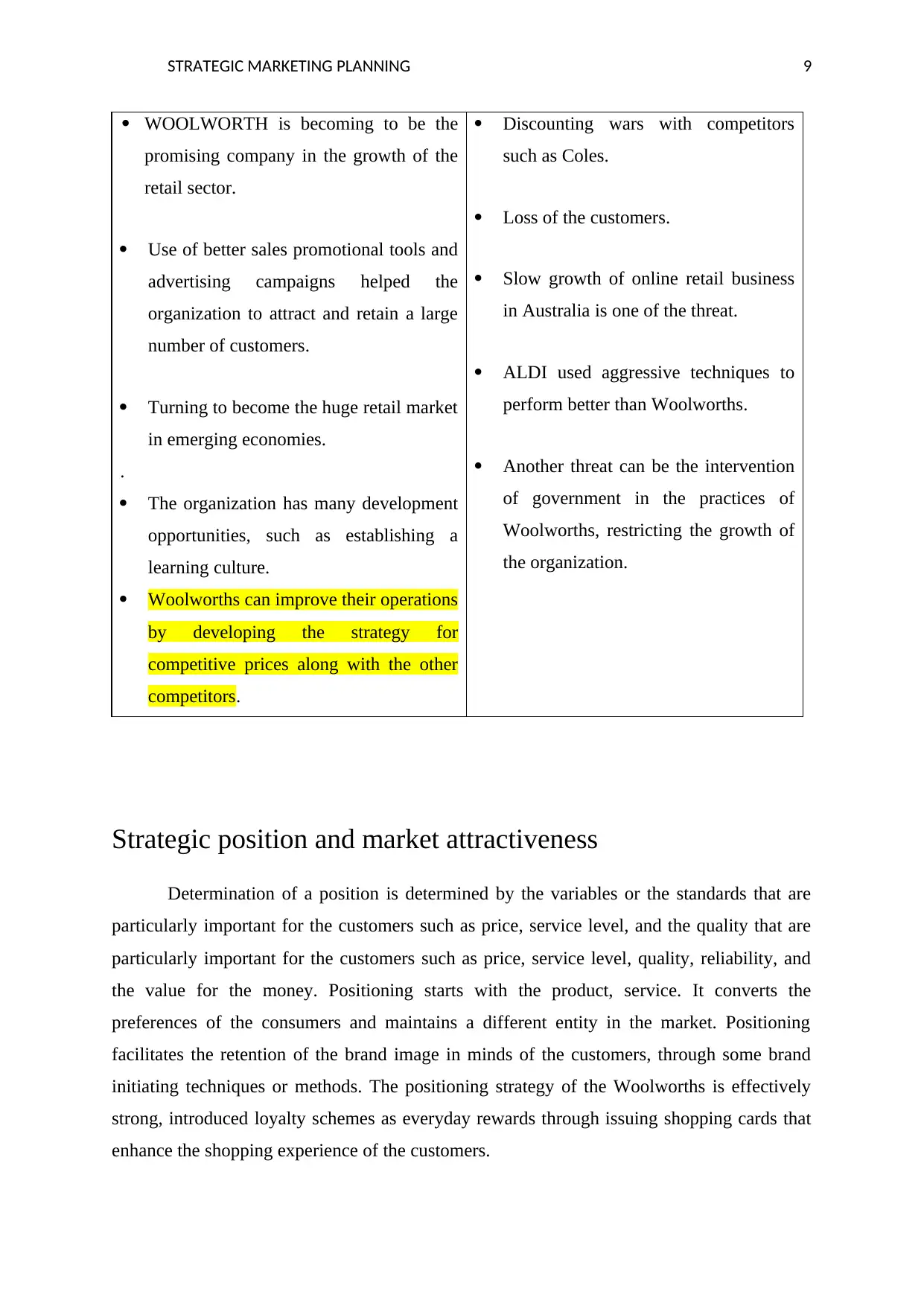
STRATEGIC MARKETING PLANNING 9
WOOLWORTH is becoming to be the
promising company in the growth of the
retail sector.
Use of better sales promotional tools and
advertising campaigns helped the
organization to attract and retain a large
number of customers.
Turning to become the huge retail market
in emerging economies.
.
The organization has many development
opportunities, such as establishing a
learning culture.
Woolworths can improve their operations
by developing the strategy for
competitive prices along with the other
competitors.
Discounting wars with competitors
such as Coles.
Loss of the customers.
Slow growth of online retail business
in Australia is one of the threat.
ALDI used aggressive techniques to
perform better than Woolworths.
Another threat can be the intervention
of government in the practices of
Woolworths, restricting the growth of
the organization.
Strategic position and market attractiveness
Determination of a position is determined by the variables or the standards that are
particularly important for the customers such as price, service level, and the quality that are
particularly important for the customers such as price, service level, quality, reliability, and
the value for the money. Positioning starts with the product, service. It converts the
preferences of the consumers and maintains a different entity in the market. Positioning
facilitates the retention of the brand image in minds of the customers, through some brand
initiating techniques or methods. The positioning strategy of the Woolworths is effectively
strong, introduced loyalty schemes as everyday rewards through issuing shopping cards that
enhance the shopping experience of the customers.
WOOLWORTH is becoming to be the
promising company in the growth of the
retail sector.
Use of better sales promotional tools and
advertising campaigns helped the
organization to attract and retain a large
number of customers.
Turning to become the huge retail market
in emerging economies.
.
The organization has many development
opportunities, such as establishing a
learning culture.
Woolworths can improve their operations
by developing the strategy for
competitive prices along with the other
competitors.
Discounting wars with competitors
such as Coles.
Loss of the customers.
Slow growth of online retail business
in Australia is one of the threat.
ALDI used aggressive techniques to
perform better than Woolworths.
Another threat can be the intervention
of government in the practices of
Woolworths, restricting the growth of
the organization.
Strategic position and market attractiveness
Determination of a position is determined by the variables or the standards that are
particularly important for the customers such as price, service level, and the quality that are
particularly important for the customers such as price, service level, quality, reliability, and
the value for the money. Positioning starts with the product, service. It converts the
preferences of the consumers and maintains a different entity in the market. Positioning
facilitates the retention of the brand image in minds of the customers, through some brand
initiating techniques or methods. The positioning strategy of the Woolworths is effectively
strong, introduced loyalty schemes as everyday rewards through issuing shopping cards that
enhance the shopping experience of the customers.
Paraphrase This Document
Need a fresh take? Get an instant paraphrase of this document with our AI Paraphraser
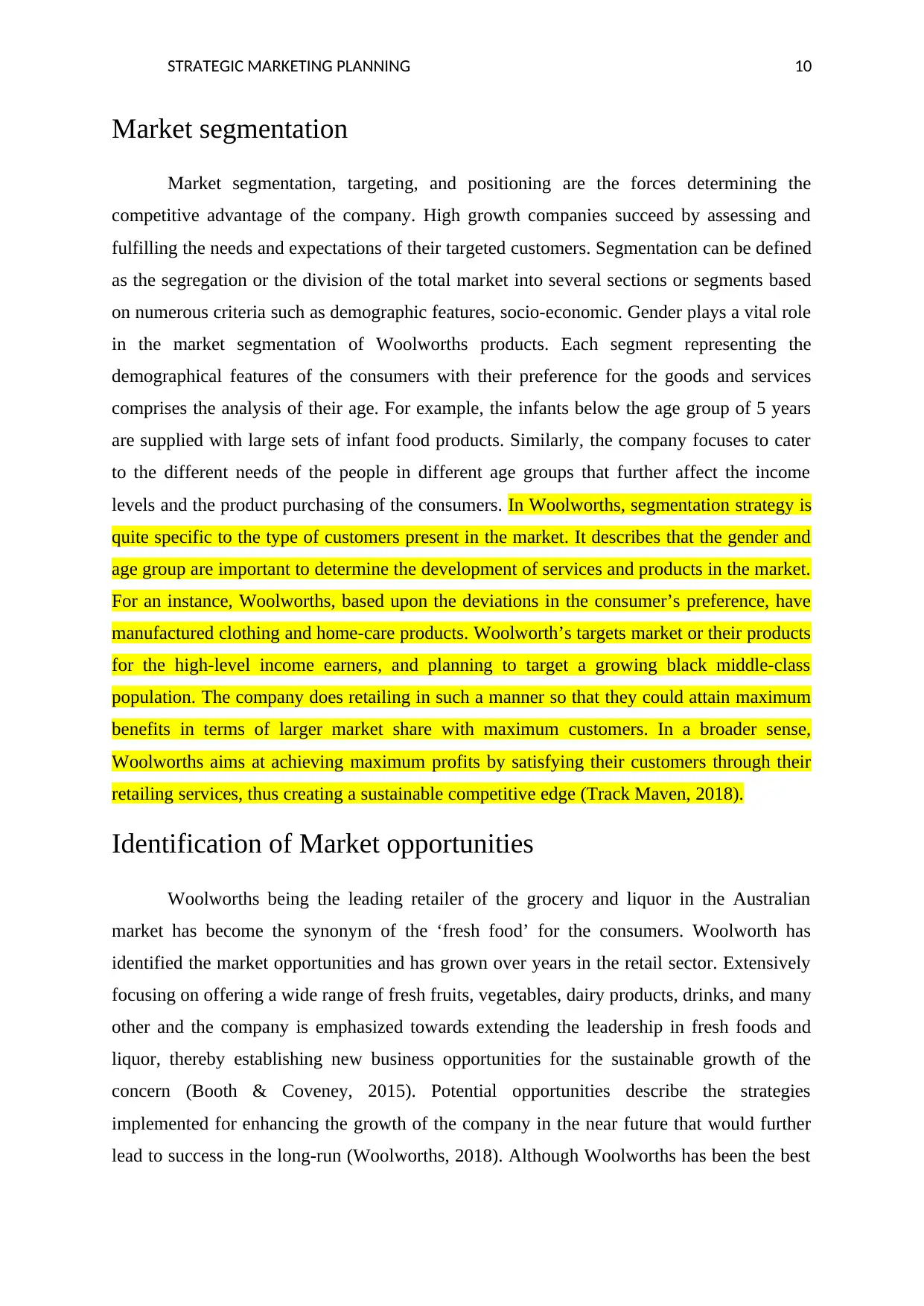
STRATEGIC MARKETING PLANNING 10
Market segmentation
Market segmentation, targeting, and positioning are the forces determining the
competitive advantage of the company. High growth companies succeed by assessing and
fulfilling the needs and expectations of their targeted customers. Segmentation can be defined
as the segregation or the division of the total market into several sections or segments based
on numerous criteria such as demographic features, socio-economic. Gender plays a vital role
in the market segmentation of Woolworths products. Each segment representing the
demographical features of the consumers with their preference for the goods and services
comprises the analysis of their age. For example, the infants below the age group of 5 years
are supplied with large sets of infant food products. Similarly, the company focuses to cater
to the different needs of the people in different age groups that further affect the income
levels and the product purchasing of the consumers. In Woolworths, segmentation strategy is
quite specific to the type of customers present in the market. It describes that the gender and
age group are important to determine the development of services and products in the market.
For an instance, Woolworths, based upon the deviations in the consumer’s preference, have
manufactured clothing and home-care products. Woolworth’s targets market or their products
for the high-level income earners, and planning to target a growing black middle-class
population. The company does retailing in such a manner so that they could attain maximum
benefits in terms of larger market share with maximum customers. In a broader sense,
Woolworths aims at achieving maximum profits by satisfying their customers through their
retailing services, thus creating a sustainable competitive edge (Track Maven, 2018).
Identification of Market opportunities
Woolworths being the leading retailer of the grocery and liquor in the Australian
market has become the synonym of the ‘fresh food’ for the consumers. Woolworth has
identified the market opportunities and has grown over years in the retail sector. Extensively
focusing on offering a wide range of fresh fruits, vegetables, dairy products, drinks, and many
other and the company is emphasized towards extending the leadership in fresh foods and
liquor, thereby establishing new business opportunities for the sustainable growth of the
concern (Booth & Coveney, 2015). Potential opportunities describe the strategies
implemented for enhancing the growth of the company in the near future that would further
lead to success in the long-run (Woolworths, 2018). Although Woolworths has been the best
Market segmentation
Market segmentation, targeting, and positioning are the forces determining the
competitive advantage of the company. High growth companies succeed by assessing and
fulfilling the needs and expectations of their targeted customers. Segmentation can be defined
as the segregation or the division of the total market into several sections or segments based
on numerous criteria such as demographic features, socio-economic. Gender plays a vital role
in the market segmentation of Woolworths products. Each segment representing the
demographical features of the consumers with their preference for the goods and services
comprises the analysis of their age. For example, the infants below the age group of 5 years
are supplied with large sets of infant food products. Similarly, the company focuses to cater
to the different needs of the people in different age groups that further affect the income
levels and the product purchasing of the consumers. In Woolworths, segmentation strategy is
quite specific to the type of customers present in the market. It describes that the gender and
age group are important to determine the development of services and products in the market.
For an instance, Woolworths, based upon the deviations in the consumer’s preference, have
manufactured clothing and home-care products. Woolworth’s targets market or their products
for the high-level income earners, and planning to target a growing black middle-class
population. The company does retailing in such a manner so that they could attain maximum
benefits in terms of larger market share with maximum customers. In a broader sense,
Woolworths aims at achieving maximum profits by satisfying their customers through their
retailing services, thus creating a sustainable competitive edge (Track Maven, 2018).
Identification of Market opportunities
Woolworths being the leading retailer of the grocery and liquor in the Australian
market has become the synonym of the ‘fresh food’ for the consumers. Woolworth has
identified the market opportunities and has grown over years in the retail sector. Extensively
focusing on offering a wide range of fresh fruits, vegetables, dairy products, drinks, and many
other and the company is emphasized towards extending the leadership in fresh foods and
liquor, thereby establishing new business opportunities for the sustainable growth of the
concern (Booth & Coveney, 2015). Potential opportunities describe the strategies
implemented for enhancing the growth of the company in the near future that would further
lead to success in the long-run (Woolworths, 2018). Although Woolworths has been the best
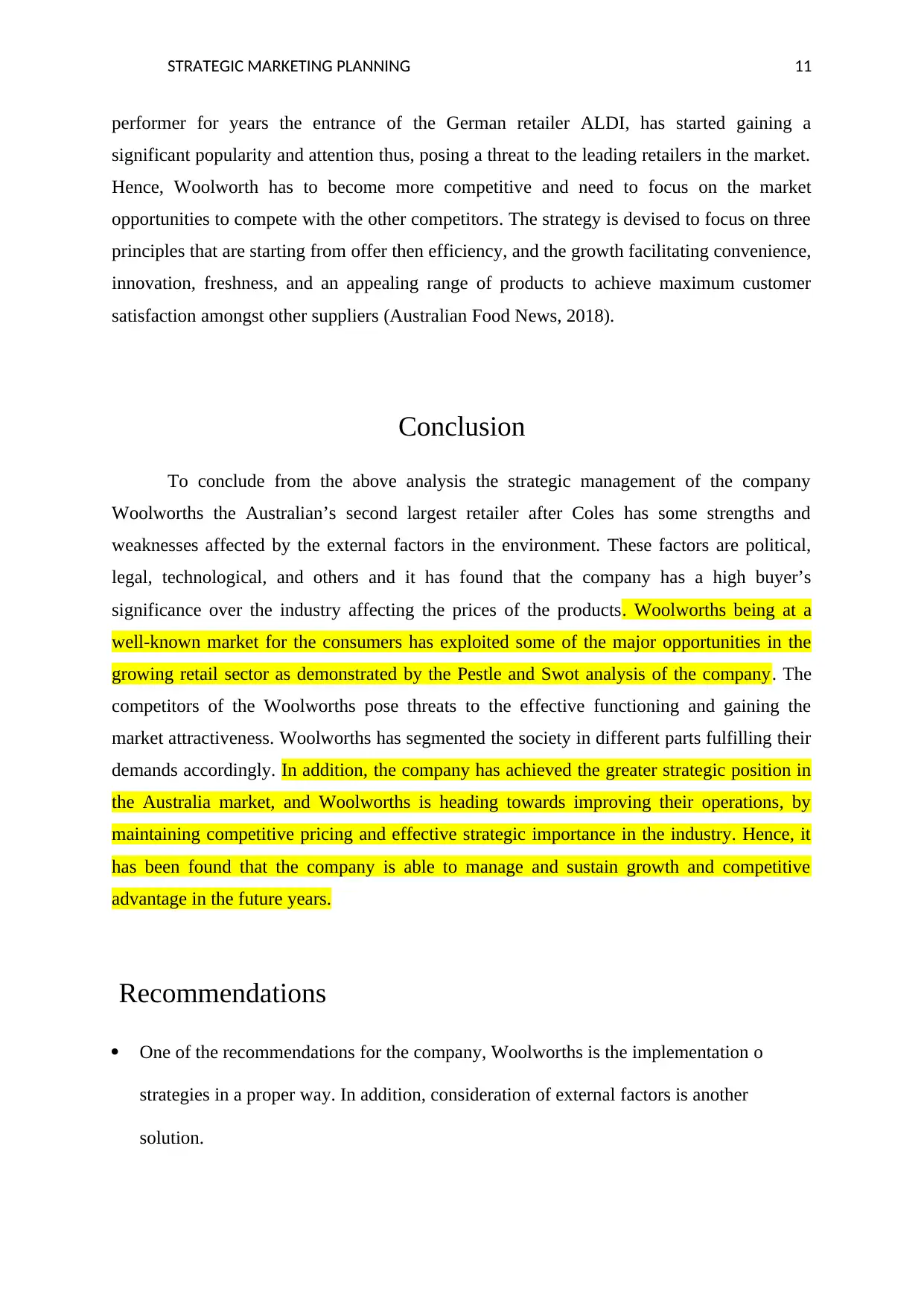
STRATEGIC MARKETING PLANNING 11
performer for years the entrance of the German retailer ALDI, has started gaining a
significant popularity and attention thus, posing a threat to the leading retailers in the market.
Hence, Woolworth has to become more competitive and need to focus on the market
opportunities to compete with the other competitors. The strategy is devised to focus on three
principles that are starting from offer then efficiency, and the growth facilitating convenience,
innovation, freshness, and an appealing range of products to achieve maximum customer
satisfaction amongst other suppliers (Australian Food News, 2018).
Conclusion
To conclude from the above analysis the strategic management of the company
Woolworths the Australian’s second largest retailer after Coles has some strengths and
weaknesses affected by the external factors in the environment. These factors are political,
legal, technological, and others and it has found that the company has a high buyer’s
significance over the industry affecting the prices of the products. Woolworths being at a
well-known market for the consumers has exploited some of the major opportunities in the
growing retail sector as demonstrated by the Pestle and Swot analysis of the company. The
competitors of the Woolworths pose threats to the effective functioning and gaining the
market attractiveness. Woolworths has segmented the society in different parts fulfilling their
demands accordingly. In addition, the company has achieved the greater strategic position in
the Australia market, and Woolworths is heading towards improving their operations, by
maintaining competitive pricing and effective strategic importance in the industry. Hence, it
has been found that the company is able to manage and sustain growth and competitive
advantage in the future years.
Recommendations
One of the recommendations for the company, Woolworths is the implementation o
strategies in a proper way. In addition, consideration of external factors is another
solution.
performer for years the entrance of the German retailer ALDI, has started gaining a
significant popularity and attention thus, posing a threat to the leading retailers in the market.
Hence, Woolworth has to become more competitive and need to focus on the market
opportunities to compete with the other competitors. The strategy is devised to focus on three
principles that are starting from offer then efficiency, and the growth facilitating convenience,
innovation, freshness, and an appealing range of products to achieve maximum customer
satisfaction amongst other suppliers (Australian Food News, 2018).
Conclusion
To conclude from the above analysis the strategic management of the company
Woolworths the Australian’s second largest retailer after Coles has some strengths and
weaknesses affected by the external factors in the environment. These factors are political,
legal, technological, and others and it has found that the company has a high buyer’s
significance over the industry affecting the prices of the products. Woolworths being at a
well-known market for the consumers has exploited some of the major opportunities in the
growing retail sector as demonstrated by the Pestle and Swot analysis of the company. The
competitors of the Woolworths pose threats to the effective functioning and gaining the
market attractiveness. Woolworths has segmented the society in different parts fulfilling their
demands accordingly. In addition, the company has achieved the greater strategic position in
the Australia market, and Woolworths is heading towards improving their operations, by
maintaining competitive pricing and effective strategic importance in the industry. Hence, it
has been found that the company is able to manage and sustain growth and competitive
advantage in the future years.
Recommendations
One of the recommendations for the company, Woolworths is the implementation o
strategies in a proper way. In addition, consideration of external factors is another
solution.
⊘ This is a preview!⊘
Do you want full access?
Subscribe today to unlock all pages.

Trusted by 1+ million students worldwide
1 out of 15